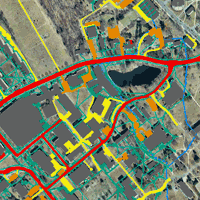
About
This website will help guide you through a way to use impervious cover as a framework to protect your community’s water resources, whether it’s in response to an “IC-TMDL,” a part of your municipal stormwater program, or just because it makes a boatload of sense. With such a riveting subject, we have made an attempt to minimize text wherever possible, relying instead on videos, maps and other visuals. You may or may not be able to completely “Do It Yourself,” but armed with information, techniques, and strategies from this website, you’ll be on your way to reducing runoff and its impacts.
This website is based on a guide book created by the Nonpoint Education for Municipal Officials (NEMO) Program of the University of Connecticut Center for Land Use Education and Research (CLEAR). In 2009 and 2010, NEMO led a team of partners in an effort to develop a practical response to the first impervious cover-based TMDL in the nation. This TMDL was issued for Eagleville Brook in Mansfield CT in 2007 by the Connecticut Department of Energy and Environmental Protection (CT DEEP). The project team included CT DEEP, several units of the University of Connecticut, the Town of Mansfield, and experts from the Center for Watershed Protection and the Horsley Witten Group. The booklet, and this website, are based on the Eagleville Brook project experience, as well as over 20 years of experience that the NEMO Program has in working with communities on stormwater and land use issues.
This website is funded by a grant from the Long Island Sound Futures Fund of the National Fish and Wildlife Foundation, in close association with the federal/state Long Island Sound Study.
This website was conceived, planned and written by Chet Arnold, Mike Dietz and Dave Dickson. Video production by Dave Dickson. Web design and development by Kara Bonsack. © University of Connecticut, 2014.




